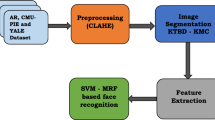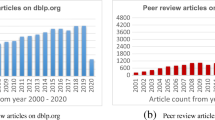Abstract
Small size sample face recognition is one of the most challenging problems in image classification. Multi-scale patch collaborative representation is an effective method to deal with this problem. The existing methods only consider the sample information at different scales, ignoring category information in the process of multi-scale information fusion. However, different categories of images contain different information, which has a great impact on face recognition results. To solve this problem, this paper proposes a multi-scale patch fuzzy decision method for face recognition with category information, which considers the influence of different category information on image classification results. Firstly, the fuzzy decision matrix is introduced to describe the degree of samples belonging to different categories at a single scale. Then, a weight vector is introduced for each category to describe the importance of patch scales in the category. Specifically, each element of a weight vector represents the weight value of each scale in the corresponding category, so that each category could get a weight vector at all scales. Finally, the optimization objective function for face recognition is constructed by considering the classification information both from the same category and from different categories. Experimental results on six face databases showed that the proposed method is robust and superior to most advanced small-size sample face recognition methods.






Similar content being viewed by others
Data availability
The raw data used in this study have been appropriately processed and securely stored. Under relevant legal and ethical frameworks, we are willing to share access to partially or fully anonymized data with interested researchers. Requests for data access should be made via email, stating the research purpose and plan. We will respond promptly and negotiate the details of data sharing as appropriate.
References
Zhu P, Qi R, Hu Q, Wang Q, Zhang C (2018) Beyond similar and dissimilar relations: a kernel regression formulation for metric learning. In: International joint conference on artificial intelligence, pp 3242–3248
Hu J, Lu J, Tan YP (2014) Discriminative deep metric learning for face verification in the wild. In: Proceedings of the IEEE conference on computer vision and pattern recognition, vol 10, pp 1875–1882
Weinberger KQ, Saul LK (2009) Distance metric learning for large margin nearest neighbor classification. J Mach Learn Res 10:207–244
Zhang X, Wang C, Fan X (2021) Convex hull-based distance metric learning for image classification. J Comput Appl Math 40:1–22
Mellal MA, Salhi A (2021) Multi-objective system design optimization via PPA and a fuzzy method. Int J Fuzzy Syst 23:1213–1221
Shun Tsai, Yi Chen (2022) A fuzzy identification method based on the likelihood function and noise clustering algorithm. Int J Fuzzy Syst. https://doi.org/10.1007/s40815-022-013
Zhang T, Lin H, Ju Z (2020) Hand gesture recognition in complex background based on convolutional pose machine and fuzzy Gaussian mixture models. Int J Fuzzy Syst 22:1330–1341
Nguyen HB, Lin CM, Huynh TT (2022) Fuzzy hybrid neural network control for uncertainty nonlinear systems based on enhancement search algorithm. Int J Fuzzy Syst 24:3384–3402
Lv X, Wang C, Fan X (2020) A novel image super-resolution algorithm based on multi-scale dense recursive fusion network. Neurocomputing 489:98–111
Miao X, Gao Y, Chen G (2016) Processing incomplete k nearest neighbor search. IEEE Trans Fuzzy Syst 24:1349–1363
Song Y, Kong X, Zhang C (2022) A large-scale-nearest neighbor classification algorithm based on neighbor relationship preservation. In: IEEE IWCMC
Li J, Lin S, Yu K (2022) Quantum K-nearest neighbor classification algorithm based on Hamming distance. Quantum Inf Process 21:1–17
Zhu P, Zhang L, Zuo W (2013) From point to set: Extend the learning of distance metrics. In: Proceedings of the IEEE international conference on computer vision, pp 2664–2671
Zhu P, Cheng H, Xu Q (2018) Towards generalized and efficient metric learning on Riemannian manifold. In: IJCAI international joint conference artificial intelligence, pp 3235–3241
Liang J, Zhu P, Dang C (2020) Semi-supervised Laplace-regularized multimodality metric learning. IEEE Trans Cybern 116:1–13
Zhu X, Zhang S, Zhu Y, Zhu P (2020) Unsupervised spectral feature selection with dynamic hyper-graph learning. IEEE Trans Knowl Data Eng. https://doi.org/10.1109/TKDE.2020.3017250
Zhang J, Yan Y, Lades M (1997) Face recognition: eigenface, elastic matching, and neural nets. In: Proceedings of the IEEE, vol 85, pp 1423–1435
Wang J (2016) Generalized 2-D principal component analysis by Lp-Norm for image analysis. IEEE Trans Cybern 46:792–803
Shuai C, Wang X, He M (2021) A presentation and retrieval hash scheme of images based on principal component analysis. Vis Comput 37:2113–2126
Zhou G, Xu G, Hao J, Chen S, Xu J, Zheng X (2021) Generalized centered 2-D principal component analysis. IEEE Trans Cybern 51:1666–1677
Eppstein D (2022) Finding relevant points for nearest-neighbor classification. In: SOSA, pp 68–78
Wright J, Yang A, Ganesh A, Sastry S, Ma Y (2009) Robust face recognition via sparse representation. IEEE Trans Pattern Anal Mach Intell 31:210–227
Zhang JL, Yang M, Feng X (2011) Sparse representation or collaborative representation: which helps face recognition? In: IEEE international conference on computer vision, pp 471–478
Cai S, Zhang L, Zuo W, Feng X (2016) A probabilistic collaborative representation-based approach for pattern classification. In: IEEE conference on computer vision and pattern recognition (CVPR), pp 2950–2959
Akhtar N, Shafait F, Mian A (2017) Efficient classification with sparsity augmented collaborative representation. Pattern Recognit 65:136–145
Su H, Yu Y, Du Q (2020) Ensemble learning for hyperspectral image classification using tangent collaborative representation. IEEE Trans Geosci Remote Sens 58:3778–3790
Zhou C, Tu B, Ren Q (2021) Spatial peak-aware collaborative representation for hyperspectral imagery classification. IEEE Trans Geosci Remote Sens 9:1–5
Kim DJ, Bien Z (2020) Design of personalized classifier using soft computing techniques for personalized facial expression recognition. IEEE Trans Fuzzy Syst 16:874–885
Dong X, Yu Z, Cao W (2020) A survey on ensemble learning. Front Comput Sci 14:241–258
Zhu P, Zhang L, Hu Q (2012) Multi-scale patch based collaborative representation for face recognition with margin distribution optimization. In: European conference on computer vision, pp 822–835
Pei S, Wang C, Fan X (2021) Cooperative representation of multiscale patch face recognition based on fuzzy decision. Int J Mach Learn 12:2109–2119
Berny A (2021) Linear representation of categorical values. In: GECCO, pp 119–120
Dong J, Pan J (2021) Learning spatially variant linear representation models for joint filtering. IEEE Trans Pattern Anal Mach Intell 1:1
Manssor S, Sun S, Elhassan M (2021) Real-time human recognition at night via integrated face and gait recognition technologies. Sensors 21:4323
Sun J, Fujita H, Zheng Y, Ai W (2021) Multi-class financial distress prediction based on support vector machines integrated with the decomposition and fusion methods. Inf Sci 559:153–170
Kumar R, Banerjee A, Vemuri B (2009) Volterrafaces: discriminant analysis using volterra kernels. In: IEEE conference on computer vision and pattern recognition, pp 150–155
Grundmann F, Epstude K, Scheibe S (2021) Face masks reduce emotion-recognition accuracy and perceived closeness. PLoS ONE 16:e0249792
Karageorgos P, Richter T, Haffmans M, Schindler J (2020) The role of word-recognition accuracy in the development of word-recognition speed and reading comprehension in primary school: a longitudinal examination. Cogn Dev 56:100949
Albiero V, Bowyer K, Vangara K, King M (2020) Does face recognition accuracy get better with age? Deep face matchers say no. In: IEEE WACV
Kim S, Lim M, Kim Y (2018) Impact of synaptic device variations on pattern recognition accuracy in a hardware neural network. Sci Rep 8:2638
Barron J (2019) A general and adaptive robust loss function. In: IEEE conference on computer vision and pattern recognition, pp 4331–4339
Rosset S, Zhu J, Hastie T (2004) Boosting as a regularized path to a maximum margin classifier. J Mach Learn Res 5:941–973
Shen C, Li H (2010) On the dual formulation of boosting algorithms. IEEE Trans Pattern Anal Mach Intell 32:2216–2231
Shawe-Taylor J, Cristianini N (1998) Robust bounds on generalization from the margin distribution. In: NeuroCOLT2
Yang AY, Genesh A, Zhou Z (2010) A review of fast l (1)-minimization algorithms for robust face recognition
Kim S, Koh K, Lustig M (2007) An interior-point method for large-scale l1-regularized logistic regression. J Mach Learn 8:1519–1555
Gross R, Mattehews I, Cohn J, Kanade T, Baker S (2010) Multipie. Image Vis Comput 28:807–813
Georghiades A, Belhumeur P, Kriegman D (2001) From few to many: illumination cone models for face recognition under variable lighting and pose. IEEE Trans Pattern Anal Mach Intell 23:643–660
Huang GB, Ramesh M, Berg T, Learned-Miller E (2008) Labeled faces in the wild: a database for studying face recognition in unconstrained environments, Month
https://www.dssz.com/3106295.html. Accessed 15 Aug 2020
Wolf L, Hassner T, Taigman Y (2010) Similarity scores based on background samples. In: Asian conference on computer vision, vol 5995, pp 88–97
Kumar R, Banerjee A, Vemuri BC, Pfister H (2011) Maximizing all margins: pushing face recognition with kernel plurality. In: IEEE International conference on computer vision, pp 2375–2382
Chen S, Liu J, Zhou Z (2004) Making FLAD applicable to face recognition with one sample per person. Pattern Recogn 37:1553–1555
Zhang SC, Liang X, Matsuyama T (2014) Generic learning-based ensemble framework for small sample size face recognition in multi-camera networks. Sensors 14:23509–23538
Ojala T, Pietikainen M, Harwood D (1996) A comparative study of texture measures with classification based on feature distributions. Pattern Recogn 29:51–59
Frobaand B, Ernst A (2004) Face detection with the modified census transform. In: IEEE conference series on automatic face and gesture recognition, pp 91–96
Jun B, Kim D (2012) Robust face detection using local gradient patterns and evidence accumulation. Pattern Recognit 45:3304–3316
Cai D, He X, Hu Y, Han J, Huang T (2007) Learning a spatially smooth subspace for face recognition. In: IEEE conference on computer vision and pattern recognition, pp 1–7
Wang F, Zhang C (2007) Feature extraction by maximizing the average neighborhood margin. In: IEEE conference on computer vision and pattern recognition, vol 2
Cai D, He X, Han J, Zhang HJ (2006) Orthogonal laplacianfaces for face recognition. IEEE Trans Image Process 15:3608–3614
Pentland A, Moghaddam B, Starner T (1994) View-based and modular eigenspaces for face recognition. In: IEEE conference on computer vision and pattern recognition, pp 84–91
Belhumeur PN, Hespanha JP, Kriegman DJ (1997) Eigenfaces vs. Fisherfaces: recognition using class specific linear projection. IEEE Trans Pattern Anal Mach Intell 19:711–720
He X, Yan S, Hu Y, Niyogi P, Zhang H (2005) Face recognition using Laplacianfaces. IEEE Trans Pattern Anal Mach Intell 27:328–340
Chakraborti T, Chatterjee A (2014) A novel binary adaptive weight GSA based feature selection for face recognition using local gradient patterns, modified census transforms, and local binary patterns. Eng Appl Artif Intell 33:80–90
Acknowledgements
This work was supported by the National Natural Science Foundation of China under Grants 11771111, 61976027, in part by the Foundation of Educational Committee of Liaoning Province under Grant JYTZD2023175.
Author information
Authors and Affiliations
Corresponding author
Additional information
Publisher's Note
Springer Nature remains neutral with regard to jurisdictional claims in published maps and institutional affiliations.
Rights and permissions
Springer Nature or its licensor (e.g. a society or other partner) holds exclusive rights to this article under a publishing agreement with the author(s) or other rightsholder(s); author self-archiving of the accepted manuscript version of this article is solely governed by the terms of such publishing agreement and applicable law.
About this article
Cite this article
Pei, S., Chen, M. & Wang, C. Multi-scale patch fuzzy decision for face recognition with category information. Int. J. Mach. Learn. & Cyber. (2024). https://doi.org/10.1007/s13042-024-02169-5
Received:
Accepted:
Published:
DOI: https://doi.org/10.1007/s13042-024-02169-5




